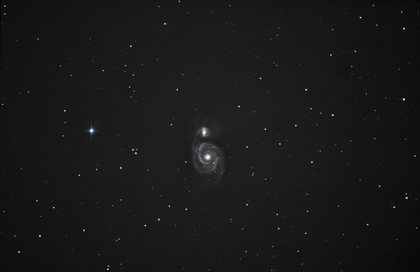HOME | DD
 insomniaworks — The Hercules Cluster
insomniaworks — The Hercules Cluster

Published: 2010-08-23 02:09:51 +0000 UTC; Views: 855; Favourites: 28; Downloads: 4
Redirect to original
Description
Messier-13 The Hercules ClusterRelated content
Comments: 24

Great shot...this incidentally was the subject of my first successful "find" when I first got my telescope
👍: 0 ⏩: 1

Thanks so much! M-13 is really a show piece, glad you got to see it 1st hand.
👍: 0 ⏩: 0

Takes the piss out of my attempt! hehe, excellent
👍: 0 ⏩: 1

Here's my first attempt at this kinda stuff, really need to get a new barlow! Results are really dark and soft, this is just one exposure, how many did you take to make this image? I was looking at a televue x2 barlow, what do you recommend? - [link]
👍: 0 ⏩: 1

Hi Gavin, Pretty good for only 30 seconds. I do not remember exactly how many exposures that shot was. I have a newer one posted [link] It was 18 x 5min exposures at ISO 800. You can get freeware called Deep Sky Stacker to do all of your stacking before processing.
Televue makes good stuff however I would recommend saving a few more bucks and go for one of their Powermates. They work better than a standard barlow. I believe they come in 2X,3X and 5X. You can get more info from their website.
Mark
👍: 0 ⏩: 1

Thanks for the advice, do you think its worth it with my current equipment? I suppose you can keep a barlow to use with an upgrades you get aswell.. I have deep sky stacker, just haven't really figured it out yet! Are the single exposures before stacking really dark to the point you cant see any detail?
👍: 0 ⏩: 1

Quality equipment is always an asset. I am sure you can find easy to follow tutorials on the web. When the exposures are short(and probably under exposed) they will appear quite dark both before and after stacking. Once stacked I use PS to stretch the levels and such to bring out the detail.
When shooting deep sky objects - Use the histogram on the camera to help you select the exposure time. Expose long enough to get the histogram to show about half saturated.
Planets and the moon will use very short exposures.
👍: 0 ⏩: 1

Thanks, yeah i'm more worried about doing all these exposures with no results straight away and being disappointed when I finally get them back on the computer! I will give it a shot though
👍: 0 ⏩: 1

We all want instant gratification. I remember when I started and was trying to do it on film. Nothing worse than getting the pics back blank or out of focus. At least now you can check instantly to see if things are working for you.
Small Steps..
Mark
👍: 0 ⏩: 0

How long did you leave the shutter open in order to get this?!
Its amazing.
👍: 0 ⏩: 1

Thanks, I'm glad you like it. It was a while ago and I'm not possitive. I believe that it was approx 1.5 hrs total exposure. 3 min subs at ISO 800. Combined with Deep Sky Stacker and Processed with PS CS2.
👍: 0 ⏩: 2

sorry to dig up this comment! I'm curious:
I heard from another photographer that anything over 30minutes and you would get blur on the stars from the rotation of the earth... how did you avoid that with 1.5 hours exposure time?
👍: 0 ⏩: 1

Anything over about 30 seconds will cause star trailing. My telescope and camera are mounted on a German Equatorial Mount. The mount has motor drives that move the scope to compensate for the rotation. Thus it enables you to keep your target centered for hours.
👍: 0 ⏩: 1

Aaah, very nice. Thanks for the information!
👍: 0 ⏩: 1

Glad I could clear it up for you!
👍: 0 ⏩: 0

Ah, Thats okay, I was just wondering
I thought it would be around 2 hours
very well done
👍: 0 ⏩: 1

Thanks. I'll go back and check my RAW files. Hopefully I will find them and I will post the info.
👍: 0 ⏩: 1

I checked my files. It was only 54 minutes total exposure. 18 X 3 min subs. @ISO 800
👍: 0 ⏩: 0





























